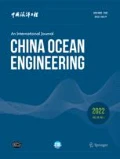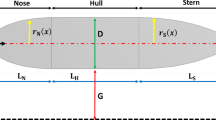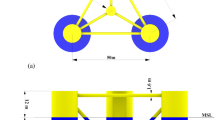Abstract
The aim of this work is to build a 3D numerical model to study the characteristics of passive drag on competitive swimmers taking into account the impact of the free surface. This model solves the 3D incompressible Navier-Stokes equations using RNG k-ɛ turbulence closure. The volume of fluid (VOF) method is used to locate the free surface. The 3D virtual model is created by Computer Aided Industrial Design (CAID) software, Rhinoceros. Firstly, a specific posture of swimming is studied. The simulation results are in good agreement with the data from mannequin towing experiments. The effects of a swimmer’s arms and legs positions on swimming performance are then studied. Finally, it is demonstrated that the present method is capable of simulating gliding near the free surface.
Similar content being viewed by others
References
Bixler, B. and Schloder, M., 1996. Computational fluid dynamics: An analytical tool for the 21st century swimming scientist, Journal of Swimming Research, 11, 4–22.
Bixler, B. and Riewald, S., 2002. Analysis of swimmer’s hand and arm in steady flow conditions using computational fluid dynamics, J. Biomech., 35(5): 713–717.
Bixler, B., Pease, D. and Fairhurst, F., 2007. The accuracy of computational fluid dynamics analysis of the passive drag of a male swimmer, Sports Biomech., 6(1): 81–98.
Clarys, J. P., 1978. Relationship of human form to passive and active hydrodynamic drag, Biomechanics VI-B University Park Press, Baltimore, 120–125.
Hou, Z. M., 1983. Analysis of the component of hydrodynamics drag in swimming, Proceedings of the 4 th National Academic Communication Conference of Biomechanics in Sports, Chengdu, 5–17.
Kolmogorov, S. V. and Duplishcheva, O. A., 1992. Active drag, useful mechanical power output and hydrodynamic force coefficient in different swimming strokes at maximal velocity, J. Biomech., 25(3): 311–318.
Lyttle, A., Blanksby, B., Elliott, B. and Lloyd, D., 1998. The effect of depth and velocity on drag during the streamlined guide, Journal of Swimming Research, 13, 15–22.
Marinho, D. A., Reis, V. M., Alves, F. B., Vilas-Boas, J. P., Machado, L., Silva, A. J. and Rouboa, A. I., 2009. Hydrodynamic drag during gliding in swimming, J. Appl. Biomech., 25(3): 253–257.
Minetti, A. E., Machtsiras, G. and Masters, J. C., 2009. The optimum finger spacing in human swimming, J. Biomech., 42(13): 2188–2190.
Mittal, R., Dong, H., Bozkurttas, M., von Loebbecke, A. and Najjar, F., 2006. Analysis of flying and swimming in nature using an immersed boundary method, Proceedings of the 36th AIAA Fluid Dynamics Conference and Exhibit, San Francisco, 1–8.
Schleihauf, R. E., 1979. A Hydrodynamic Analysis of Swimming Propulsion, Swimming III, University Park Press, Baltimore, 70–117.
Toussaint, H. M., de Groot, G., Savelberg, H. H. C. M., Vervoorn, K., Hollander, A. P. and van Ingen Schenau, G. J., 1988. Active drag related to velocity in male and female swimmers, J. Biomech., 21(5): 435–438.
Zaïdi., H., Taiar, R., Fohanno, S. and Polidori, G., 2008. Analysis of the effect of swimmer’s head position on swimming performance using computational fluid dynamics, J. Biomech., 41(6): 1350–1358.
Zhan, J. M., Yu, L. H., Li, C. W., Li, Y. S., Zhou, Q. and Han, Y., 2014. A 3-D model for irregular wave propagation over partly vegetated waters, Ocean Eng., 75, 138–147.
Author information
Authors and Affiliations
Corresponding author
Additional information
This work was financially supported by the Fundamental Research Funds for the Central Universities of China.
Rights and permissions
About this article
Cite this article
Zhan, Jm., Li, Tz., Chen, Xb. et al. 3D numerical simulation analysis of passive drag near free surface in swimming. China Ocean Eng 29, 265–273 (2015). https://doi.org/10.1007/s13344-014-0080-x
Received:
Revised:
Accepted:
Published:
Issue Date:
DOI: https://doi.org/10.1007/s13344-014-0080-x




